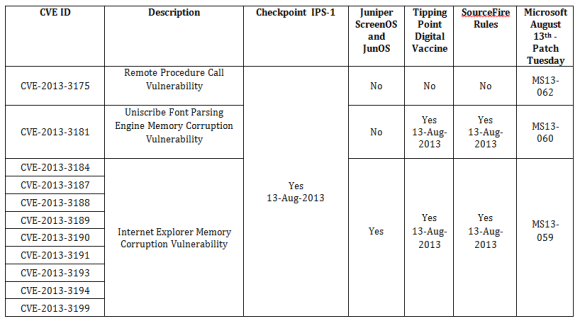The CVE August Awareness Bulletin is a personal initiative and experience that aims to provide further intelligence and analysis concerning the last vulnerabilities published by the National Institute of Standards and Technology (NIST) National Vulnerability Database (NVD) and the vendors coverage for this vulnerabilities.
Common Vulnerabilities and Exposures (CVE) is a public list of common names made available by MITRE Corporation for vulnerabilities and exposures that are publicly known.
This is the most popular list of vulnerabilities used as a reference across the security industry. It should not be considered as absolute but due to nature of its mission and current sponsors – Department of Homeland Security (DHS) National Cybersecurity and Communications Integration Center (NCCIC) – it carries a great amount of adoption across the industry.
Based on this public information I decided to take a look what has been publicized during the month of August. As of today, there were 300 vulnerabilities discovered In the current month where 40 security vulnerabilities were published with a Common Vulnerability Scoring System (CVSS) score of 8 or higher – CVSS provides a standardized method for rating vulnerabilities using a scoring system based on their different properties -. From these security vulnerabilities, I compared the last signature updates available from Juniper, Checkpoint, Tipping point and SourceFire for their NSM and IPS-1, SMS and DigitalCenter products respectively. The result is that at the moment Checkpoint, Tipping point and Sourcefire have 25% coverage and Juniper 22,5%,
Eleven of forty published security vulnerabilities are related to Microsoft products. From these eleven, nine of them affect Internet Explorer. Checkpoint, TippingPoint, SourceFire covers ten of the eleven vulnerabilities. Juniper only covers the ones related to Internet Explorer and not protecting against the CVE-2013-3175 and CVE-2013-3181.
The following graph illustrates the mapping between the CVEs published in August with a CVSS equal or higher than 8 by type and the vendor coverage:
The following table shows the August published CVEs related to Microsoft products that have been covered in the latest Checkpoint, Juniper, Tipping Point and SourceFire signature updates. It also includes the related Microsoft security bulletin:
Interesting that it looks like that Microsoft patch Tuesday is somehow coordinated with the security vendors signature updates. The ones analyzed have provided signatures on the same date (13 of August). The mentioned signatures and patches should be applied as soon as possible but you should also fully evaluate them (when possible) before applying it production systems.
For further reference I include here where you can check the signatures on Juniper NSM and Checkpoint SmartCenter Server.
For Juniper NSM you can check the signatures under Configure – Object Manager – Attack Objects – IDP Objects:
For Checkpoint IPS-1 you can check the signatures under IPS – Protections – By Type – Signatures:
For TippingPoint, on the SMS, go to Profiles. Then, from the navigation pane on the left, click the + sign next to the IPS Profiles to expand the category. Then select the search type (global or standard). The Profiles – Search screen displays and is divided in four areas. In the Filter Criteria are you can click the arrow next to it and specify the CVE id.
For SourceFire you can locate rules based on CVE numbers from within your intrusion policy by searching all rules using a certain search filter. Go to Policies – Intrusion – Intrusion Policy. Choose “Edit” next to your policy. Click on Rules. In the search filter, type “reference:” followed by the CVE that you wish to look for.
In addition, after deploying signature updates to the sensors you should check which signatures have been enabled by default. Plus you should be checking and evaluating what is the impact on your environment for the CVEs that don’t have coverage.
Bottom line, the vendors that were analyzed have pretty quick and decent coverage for the signatures that are related to the big software vendors e.g., Microsoft. However, in August we saw 40 vulnerabilities with a CVSS higher than 8 but only 25% of them have coverage. This means 75% of the published vulnerabilities don’t have coverage. Interesting to note that these vulnerabilities are related to software that don’t have significant penetration in the market. Noteworthy, is that 5 vulnerabilities are related to Mozilla Firefox (CVE-2013-1701, CVE-2013-1702,CVE-2013-1704, CVE-2013-1705 and CVE-2013-1710) and they are not covered. Even if the vendors would have 100% coverage for all vulnerabilities they would not apply to all environments. So it’s key that you know your infrastructure, your assets and mainly where are and what are your business crown jewels. Then you should know how to protect your intellectual property and what will be the impact if your intellectual property gets disclosed, altered or destroyed.




